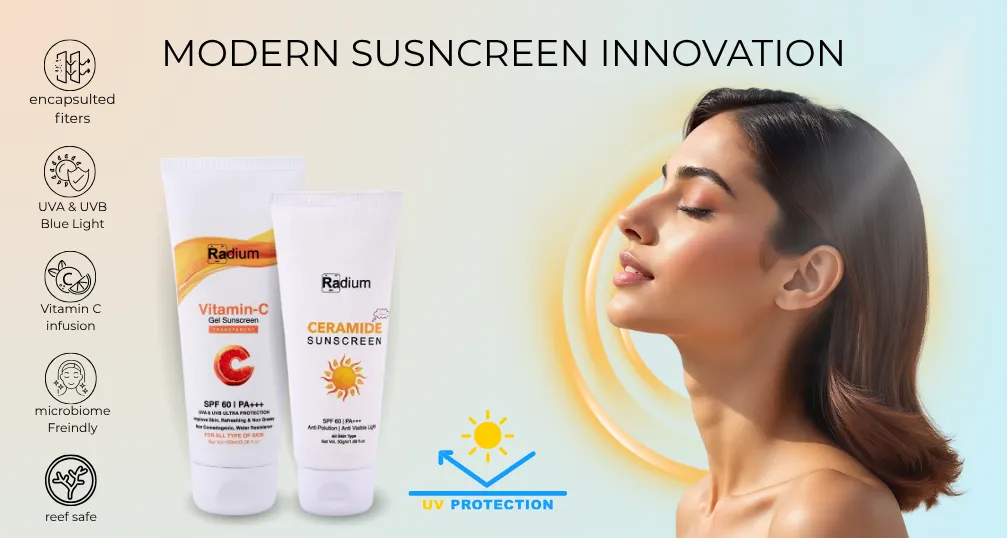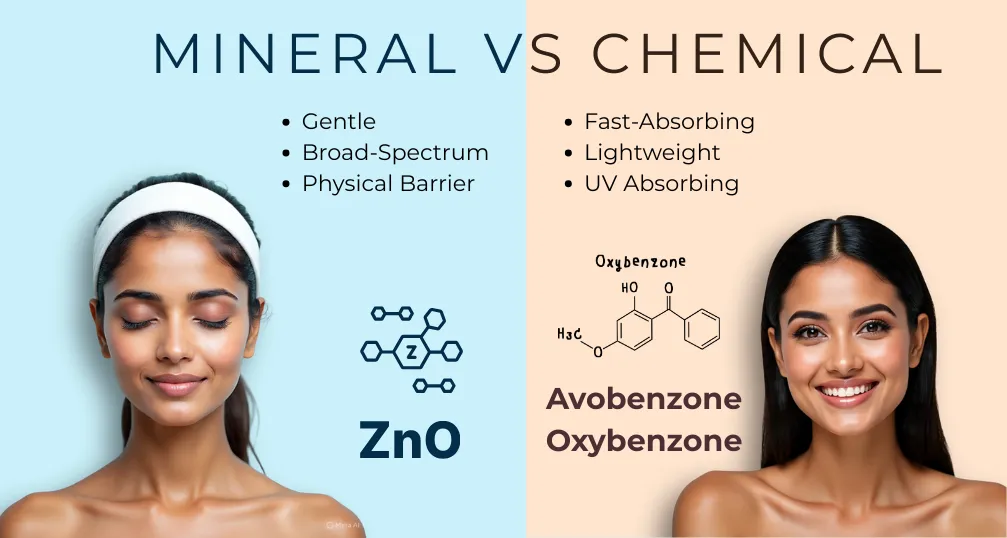As sun care science progresses, there is a debate between minerals and chemical sunscreen. Once a simple choice between white-cast zinc cream and ultra-shares chemical options, today’s sunscreen shelves are filled with innovative yogas, from blue light conservation to antioxidant infusions and reef-safe labels. But what is really new in the world of SPF- and how are these new generation products compared when talking about skin health, performance and stability?
In this blog, we break the latest trends and technologies in minerals and chemical sunscreen, to find out what sets in separating the latest formulas, and helps you decide what type of sun safety is appropriate for your skin and lifestyle in 2025.. Whether you’re shopping for a sensitive-screw solution, looking for hybrid sunscreen you find.
Understanding the Basics: Mineral vs. Chemical Sunscreens
Sunscreens are crucial for defending the skin from dangerous UV rays, but no longer all sunscreens are created equal. They often fall into two categories: mineral (physical) and chemical (natural).Each type works otherwise and offers distinct benefits.
Mineral Sunscreens
Mineral sunscreens, additionally called physical sunscreens, incorporate active substances like zinc oxide and titanium dioxide.They provide broad-spectrum safety towards both UVA and UVB rays and are less likely to irritate sensitive skin.
For instance, radium ceramide sunscreen contains zinc oxide, which offers broad-spectrum protection. In addition, it contains ceramides, which can be lipids that help to improve and grip herbal barrier of the skin, and hyaluronic acid, an effective human, that draws moisture to the pores and skin, ensures that hydration and dryness.This combination makes it appropriate for all pores and skin kinds, including touchy and dry pores and skin.
Chemical Sunscreens
Chemical sunscreen includes advengone and oxybenzone. These elements take in UV rays and rework them into innocent heat, which is then launched from the skin.They will be inclined to be lighter in texture and are often desired for each day put on due to their non-greasy finish.
Radium Gel Sunscreen is an example of a chemical sunscreen that combines vitamin C with SPF 60 PA+++, offering safety in opposition to each UVA and UVB rays.
Its gel-based components ensure brief absorption without leaving a white forged, making it perfect for each day use. The inclusion of vitamin C presents additional antioxidant benefits, assisting to brighten the pores and skin and fight signs and symptoms of getting old.
What’s New in Mineral Sunscreens? Innovations in Texture, Transparency, and Skin Compatibility
Mineral sunscreens have long been desired for his or her gentle, huge-spectrum protection, specially for touchy pores and skin. Traditionally, but, they had been regularly associated with a thick, greasy texture and a significant white solid. Recent improvements in formulation have addressed those issues, resulting in mineral sunscreens that provide more suitable aesthetics and pores and skin compatibility.
Enhanced Texture and Transparency
Modern mineral sunscreens are now formulated with micronized or nano-sized zinc oxide particles, which can be significantly smaller than conventional ones. This cut price in particle duration permits for higher dispersion at the pores and skin, mainly to an extra obvious finish. Products just like the Radium Ceramide Sunscreen make use of these superior formulations, making sure a lightweight software that absorbs quickly without leaving a white residue. Such improvements make mineral sunscreens more suitable for day by day use across diverse skin tones.
Improved Skin Compatibility
Progress in mineral sunscreen formulations also have targeted improvement of pores and skin compatibility. The inclusion of hydrating elements like hyaluronic acid and ceramides allows to preserve the pores and skin’s moisture stability, preventing the dryness regularly related to solar publicity.The Radium Ceramide Sunscreen, as an instance, combines ceramides with SPF protection to no longer only guard the pores and skin from UV rays but additionally to help the pores and skin’s natural barrier and maintain moisture.
These upgrades reflect a wider trend within the dermatological company in the direction of creating products that not only protect, but nourish the skin, making mineral sunscreens a more appealing option for a broader consumer base.
The Evolution of Chemical Sunscreens: Modern Filters, Improved Photostability, and Enhanced Safety Profiles
Chemical sunscreens have come a long way in the past decade, and have eliminated previously troubling problems around efficacy, instability, and safety. These advancements have brought the creation of more efficacious and user-friendly solar protection products.

Modern Filters for Broad-Spectrum Protection
Traditional chemical sunscreens often depended on a restricted form of UV filters, that could depart gaps in safety.Recent formulations have brought superior filters that provide broader and further powerful coverage in competition to every UVA and UVB rays. For instance, the Radium Gel Sunscreen contains Vitamin C, recognized for its antioxidant houses, to beautify skin defense in opposition to UV-precipitated harm .
Improved Photostability
Photostability refers to a sunscreen’s functionality to keep its protective residences even as uncovered to daytime. New-generation chemical filters were designed to be greater photostable, ensuring longer-lasting protection without degradation. This improvement reduces the need for common reapplication and complements the general effectiveness of the sunscreen.
Enhanced Safety Profiles
Safety has constantly been a primary scenario with chemical sunscreens. Advancements have caused the improvement of filters with higher protection profiles, minimizing capacity contamination or damaging reactions. These more recent formulations are often dermatologically tested and suitable for numerous skin types, which includes sensitive skin.
The Radium Gel Sunscreen exemplifies these advancements, providing a lightweight, non-greasy method that absorbs quickly without leaving a white solid. Its inclusion of Vitamin C not only presents sun safety but also helps in brightening the pores and skin and combating signs and symptoms of growing old .
Which Sunscreen Is Right for You? A Decision Guide Based on Skin Type, Lifestyle, and Personal Values
Choosing the proper sunscreen goes beyond SPF numbers; it’s approximately aligning your choice with your skin’s desires, day by day activities, and private values. Both Radium Ceramide Sunscreen and Radium Gel Sunscreen offer specific benefits tailored to different preferences and necessities. Here’s how to decide which one fits you first-rate:
For Dry or Sensitive Skin
You’ll love the Radium Ceramide Sunscreen if you’re dry, sensitive, and reactive. The combination of ceramides, hyaluronic acid, and aloe vera ingredients are designed to repair the natural barrier and moisture levels of your skin and calm any reactions. You can also use the sunscreen every day, as it is non-comedogenic and free of all the bad stuff! So, you won’t experience any dryness or annoyance!
For Oily or Acne-Prone Skin
The Radium Gel Sunscreen is typically recommended for people with oily or blemish-prone skin, as it features a lightweight, non-greasy formula that absorbs quickly while also leaving no white cast. The gel texture will finish on a matte base and reduce shine to avoid clogged pores. Plus, the Vitamin C adds antioxidant protection to help improve the skin and fight the signs of aging.
For Active Lifestyles
If you are often outdoors, conducting sports, or uncovered to environmental stressors, both sunscreens offer huge-spectrum protection. The Radium Ceramide Sunscreen offers SPF 60 PA+++, shielding towards UVA, UVB, and visible mild, whilst also shielding in opposition to pollution. Its anti-pollutants and anti-visible light homes make it ideal for the ones uncovered to virtual monitors and concrete environments.
For Minimalist Skincare Routines
If you decide upon a streamlined skin care habit, the Radium Gel Sunscreen serves as an all-in-one product, combining solar safety with antioxidant blessings. Its lightweight gel formula is easy to use and appropriate for everyday use, presenting powerful solar protection without the want for added layers.
For Eco-Conscious Consumers
Both sunscreens are dermatologically tested, cruelty-loose, and loose from parabens and artificial fragrances. If helping vegan and eco-aware manufacturers align together with your values, those products provide solar safety without compromising on ethical requirements.
The Future of Sun Protection: What’s on the Horizon?
The landscape of sun care is hastily evolving, pushed through improvements in generation, sustainability, and customer call for multifunctional merchandise. As we appear to destiny, several rising trends and innovations are set to redefine how we approach solar protection.
1. Encapsulated Sunscreen Technology
Encapsulation strategies, including liposomes and nanostructured lipid vendors, are being hired to protect UV filters from environmental degradation, enhancing their balance and efficacy. This technology guarantees extended solar safety and progressed sensory attributes, supplying a more great application revel in.
2. Microbiome-Friendly Formulations
Recognizing the significance of the pores and skin’s microbiome, brands are growing sunscreens that protect against UV rays even as preserving the stability of useful skin microorganisms. These formulations intend to support universal pores and skin health and resilience.
3. Personalized Sun Protection
Advancements in synthetic intelligence and pores and skin analysis equipment are permitting the creation of personalized sunscreen products tailor-made to character pores and skin sorts, tones, and solar publicity conduct. This customization guarantees the most safety and provides specific skin concerns.
4. Biodegradable and reef-safe components
With the increasing validity of the environmental impact, there is a change in the direction of sunscreen formed with biodegradable and reef-secure components. These products also aim to provide effective UV safety to reduce damage to marine ecosystems.
5. Multiple Skin Care Integration
“Skinification” fashion maintains to influence solar care, which is a major sunscreen improvement that provides additional benefits of skin care. The formulations now include substances such as hyaluronic acid, niacinamide, and peptides; hydration along with the safety of the sun, gives bright and growing old results.
Conclusion: Smarter Sun Protection for Every Skin
As sun care maintains to adapt, choosing the right sunscreen has come to be greater approximately personalization than one-size-fits-all solutions. Whether you’re drawn to the herbal enchantment and pores and skin-soothing blessings of mineral sunscreens just like the Radium Ceramide Sunscreen, or decide on the lightweight, fast-soaking up feel of chemical sunscreens consisting of the Radium Gel Sunscreen, trendy formulations provide something for every pores and skin type, way of life, and value system.
With improvements in transparency, skin compatibility, photostability, and delivered skincare advantages, sunscreens are now as state-of-the-art as every other step for your ordinary. And with future innovations like microbiome-friendly elements and customized UV safety on the horizon, it’s clear that sun care is turning into smarter, more secure, and more sustainable than ever.
In the end, high-quality sunscreen is the only thing you will use each day—so pick what works for you and put on it always. Your skin will be thankful, now and for many years to come.
FAQs
Que: What is the difference between mineral and chemical sunscreen?
Ans: Mineral sunscreen sits at the pores and skin to mirror UV rays, while chemicals absorb them.
Que: Are mineral sunscreens better for sensitive pores and skin?
Ans: Yes, mineral sunscreens are normally gentler and much less demanding for sensitive pores and skin.
Que: Do new sunscreen formulations offer higher protection?
Ans: Yes, more recent formulations regularly provide broader UV insurance and improved wearability.
Que: Can I wear sunscreen beneath make-up?
Ans: Absolutely—many modern-day sunscreens are designed to layer nicely under make-up.
Que: Are there green options inside the modern sunscreens?
Ans: Yes, many manufacturers now offer reef-secure and biodegradable sunscreen formulations.
